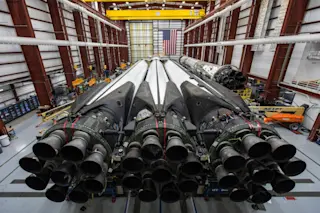Falcon Heavy's three Falcon 9 components are clearly on display in the hangar before its Wednesday launch. (Credit: SpaceX) SpaceX’s Falcon Heavy will launch on its first commercial flight tomorrow. The rocket launch was postponed from early April due to unspecified concerns, and then postponed again just this week due to weather. But Wednesday has a clear forecast with an 80 percent probability of a launch, so odds are good the mission will proceed. The launch window opens at 6:35 p.m. EDT. Falcon Heavy is a modified version of SpaceX’s standard Falcon 9 rocket, essentially made up of three Falcon 9’s strapped together, albeit with a reinforced center core. It was built to serve as SpaceX’s heavy lift vehicle, with five million pounds of thrust capable of putting even large payloads into Earth orbit and beyond. Falcon Heavy’s actual payload tomorrow is the Saudi Arabian Arabsat-6A communications satellite, weighing a ...
SpaceX's Falcon Heavy Prepares for First Commercial Liftoff Wednesday
Excitement builds as the Falcon Heavy launch approaches, marking SpaceX's first commercial flight tomorrow at 6:35 p.m. EDT.
More on Discover
Stay Curious
SubscribeTo The Magazine
Save up to 40% off the cover price when you subscribe to Discover magazine.
Subscribe













